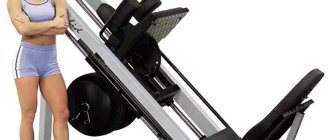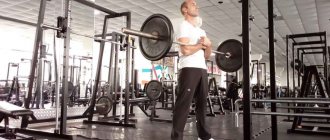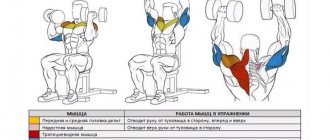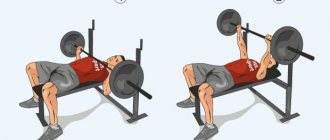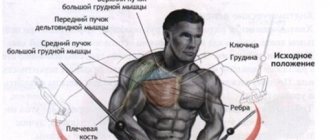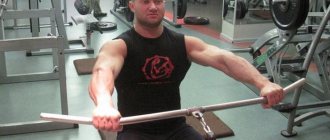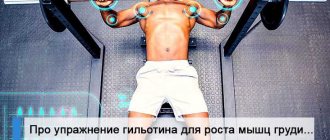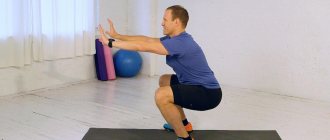Publication date: December 24, 2020.
Broad shoulders adorn both male and female figures. For guys, they are, first of all, an indicator of strength and masculinity, and girls like the fact that, thanks to wide shoulders, the waist seems narrower.
Conventionally, the shoulders can be divided into two hemispheres - front and back. The latter works when performing traction movements, that is, in those cases when you bring the weight closer to you.
The anterior hemisphere, accordingly, is used primarily when pushing the load away from the body.
This is exactly the movement that occurs when performing a seated chest press. Let's look at it in more detail.
Anatomy of the muscles of the shoulder girdle
The best way to build any muscle or muscle group is to perform its primary function. Simply put, to load the deltoid muscle you need to select the movements that it performs. And here the main difficulties begin, because the deltas consist of three heads (or bundles), each of which performs its own task. Even the simplest understanding of the functions of each head will help you avoid mistakes. For example, when, when training the shoulder joint, instead of the middle deltoid, the anterior deltoid works in the exercises.
If you do not go into anatomical features and briefly consider the functions of each head of the deltas, you can derive the following rules:
- Front - turn the arm inward, lift forward and upward, flex the shoulder;
- Medium – abduction and elevation of the arm to the sides;
- Back – turning the arm outward, lowering the arm down, extending the shoulder.
It is important to understand that in bodybuilding there are practically no movements that would involve all three heads. This means that you need to perform not only basic exercises, which usually involve 2 heads, but also isolation movements in order to purposefully “finish off” each of them.
With the right approach to shoulder training, you can load all three shoulder deltoids even at home. For muscles there is no division between the concepts of “gym” or “home”; the key is only the load and the execution of a specific movement. Therefore, it is the understanding of the anatomical functions and features of the exercise that will allow you to achieve your goal.
How to avoid mistakes?
As mentioned above, despite the fairly easy execution technique, many trainees continue to make a number of mistakes. During the movement, it is recommended to carefully monitor the technique and avoid mistakes. Let's try to look at them in more detail:
- Bad warm-up. The deltoids are a fairly “delicate” muscle and need to be thoroughly warmed up. Therefore, before starting the exercise, it is recommended to work out the joints and ligaments well. This will avoid injury and increase the effectiveness of the exercise.
- Incorrect breathing. As with any other exercise, it is important to monitor your breathing technique. Only by breathing correctly can you ensure effective functioning of the target muscle. It is not recommended to hold your breath, as this can lead to increased blood pressure.
- Sudden movements, jerks, lack of control. Raising and lowering dumbbells should be done under control and smoothly. The shoulder joints do not really like sudden and dynamic movements. This may negatively affect their condition.
- Impact of projectiles at the top point. A light touch is not scary. But the emphasis can be fraught with unpleasant inertia, which will disrupt the movement technique. Therefore, it is recommended to control the projectiles. It is advisable to brake them at a distance of several cm from each other.
- Long pause at the bottom. As a rule, it is recommended to linger for no more than one second. After all, this position is not entirely natural for the shoulder joint. Especially if you lower it as low as possible.
- Cheating. When a trainee takes on too much weight for the target muscle to handle, others come to the rescue. This causes jerking, separation of the back and neck, disruption of the body position, and the load is redistributed to other muscle groups. This can cause injury.
- Fixing the elbows during the exercise. Hands should clearly move along one trajectory. If you do not fix them and bring your elbows forward, the load will fall on the triceps. And the deltas, accordingly, will be loaded worse.
- Synchronicity of movement. Hands should move synchronously. To do this, it is recommended to observe yourself in the reflection of the mirror.
Doing it in front of a mirror is good, but it would be better to ask a coach or a more experienced friend to monitor the technique.
The best exercises for the anterior deltoid
In bodybuilding, there is often an opinion that the front bun receives the most load. This is due to the predominance of pressing movements in which it is included in the work. However, this does not mean at all that you can not do exercises for the anterior delta. Firstly, it gives the shoulder an incredibly sporty look. Secondly, it is the front “hemisphere” that is the peak of aesthetics, thanks to which many pros have become famous.
Therefore, it is possible and necessary to train the front bundle. All that sets it apart from other delt heads is the thought behind the recovery, especially when the shoulder workout is very close to the chest workout. Now let's look at the most effective exercises that will allow you to achieve the legendary peak front deltoid, which will become the signature calling card of any athlete.
Smith Barbell Front Press
One of the most popular basic movements, which involves two beams at once, middle and front. There are two versions of the Smith machine shoulder press, but it is the “chest” version that allows you to progress in weight and strength. Unlike the military press, the peculiarity of doing it in Smith is that the back is turned off from the work. In Smith, any inertia is eliminated; the machine allows you to fix the weight, leaving only vertical movement. Thanks to this, the entire load falls on the deltas.
Technique: Position the back of the bench at a 90-degree angle and place the bar at the desired height (above your head). Take the barbell with a wide grip (wider than shoulder level), remove it from the clamps and press the weight above you. At the top point, you cannot fully extend your elbows so as not to load the joints and maintain tension in the muscles. Slowly lower the bar down, trying to get the bar below your chin. After this, press the weight powerfully and return the bar to its original position.
Army press
It is considered the main basic exercise for developing powerful shoulders. The exercise loads the anterior and middle deltoids. Most often it is performed while standing, although to eliminate back pain, the military press can also be done in a sitting position.
Technique: feet shoulder-width apart, back straight. The barbell must be taken with a wide grip (thumb should be at the level of the middle deltoid) and placed at the level of the collarbone. Next, press the weight up at a fast pace, pause, and then slowly return the bar to the starting position.
Lifting/swinging dumbbells in front of you while standing/sitting
Often swinging or lifting a weight in front of you is called a compound movement, which is a misconception. This is an incredibly high-quality exercise that, if performed correctly, will be strictly isolating in nature. Swings with dumbbells are more effective than other isolating exercises for the front delts, making them an essential part of shoulder training for athletes of any level.
Technique: stand straight, feet shoulder-width apart, dumbbells near your hips. Slowly lift the weight in front of you until your arm is parallel to the floor. Lifting higher will significantly reduce the efficiency of the swing.
To eliminate the work of the back muscles or inertia when performing swings, the movement is done in a sitting position. This makes it possible to work on the front beam even better.
Front beam in crossover
Crossover front raises are a great way to create variety in the same exercise. When performing the exercise using a lower crossover block, you can make the lifts even more isolating. This allows you to load the front beam of deltas with filigree precision.
Technique: stand with your back to the machine and grab the handle with both hands. The cable of the lower block must pass between the legs. Raise the handle until your arms are parallel to the floor. To diversify the load, use regular and rope handles. You can also perform the exercise with one hand using a D-shaped handle.
Strength or volume?
In fact, it all depends on the sport. In tennis, team sports, rowing and other sports where muscle endurance and joint health are required, strength is usually developed in the off-season, and a maintenance regime is used during the competitive period.
In bodybuilding, they either work in “mass and cut” cycles, or simply perform exercises in a maintenance mode for as many repetitions as are optimal for the recovery of a particular athlete.
For normal life, you need a moderate combination of joint mobility, muscle endurance and strength. The fact is that holding weights above your head, lifting objects, and even simply holding a handrail in transport requires a combination of strength and endurance.
Important: Shoulder muscle training should combine both strength and endurance elements. There is no universal set-repetition regime for everyone. Some athletes initially have more developed strength, while others have more endurance.
The best exercises for the middle deltoid
Now let's look at the best exercises for the middle delta. It is this that allows you to make your shoulders wider. The peculiarity of working with the middle beam is that it is perfectly loaded with basic movements for the shoulders. Therefore, when working on this area, you will in any case include other heads in the work, which is a significant advantage.
Seated dumbbell press
Some exercises for the front delts are ideal for the middle section, and the seated dumbbell press is a prime example. You can progress almost endlessly in the bench press, and the exercise itself is so effective that it has become almost mandatory for all athletes.
Technique: Take dumbbells in your hands and hold them at collarbone level. Use an overhand grip (palms facing forward). Press the dumbbells upward without straightening your elbow completely. At the top point, pause briefly, then slowly return the dumbbells to the starting position.
Barbell row to the chin
In this exercise, not only the middle delta works, but also the anterior beam. Moreover, by manipulating the width of the grip, you can even achieve inclusion of the rear head in the work, although the load on it will be much less. This is why the pull-up is often called the most powerful shoulder exercise overall, ranking on par with the military press and other compound movements.
Technique: stand straight, hold the barbell with an overhand grip (medium width). The back should be straight. Lift the bar up, pulling it as close to your body as possible. Pull the bar as high as possible towards your chin, pause briefly at the top and slowly lower the weight to the starting position.
Smith overhead press
This is another good exercise for the deltas, which simultaneously loads two beams at once - the middle and the front. The big advantage of the Smith machine is that you don’t have to worry about the bar tilting to the side, because this option is less risky than working with free weights. This allows you to lift heavier weights and progress much faster.
Technique: Position the bench so that the back is above the bar. Sit on a bench, pressing your back and lower back firmly to the surface. Remove the bar from the clamps and slowly lower it down to neck level. With a powerful movement, press the weight up and return the bar to the starting position.
Dumbbell swings to the sides while standing/sitting
An exercise with shoulder abduction to the side is what is needed for the middle delta, therefore no training program can do without swings. Despite the term "swing", this exercise is best done at a moderate pace, performing the movement under control and without inertia.
Technique: stand straight. Hold dumbbells on your free hands near the outer thigh. At a moderate pace, raise your arms to the sides until your hand is at shoulder level. Additionally, turn your palm down so that your little finger is above your steel fingers. Slowly lower the dumbbells and return the weight to the starting position.
To minimize inertia, eliminate body sway, and focus the load on the middle bundle, perform the exercise in a sitting position.
Execution options
Seated chest press
The main thing for this exercise is to place your hands on the bar slightly wider than your shoulders. However, depending on the individual anatomy, as well as the goals and objectives of performing the bench press, it can be slightly changed.
With a narrow grip, the front deltas work to the maximum. Wide, accordingly, allows you to transfer a significant part of the load to the side buns - it is perfect if your goal is wide shoulders.
Overhead press
This embodiment allows you to exclude the chest from work as much as possible, transferring almost the entire load to the deltoids.
At the same time, the lateral and even posterior bundles of the deltoid muscles, which are weakly involved when pressing the barbell from the chest, are more actively involved in the work.
Bent-over barbell press
This option involves performing bench presses while sitting on an incline bench. This technique allows you to give maximum load to the pectoral muscles. The required backrest angle is 30-45 degrees.
The best rear delt exercises
The posterior bundle of deltas always receives less load. Therefore, most often athletes focus on this head and, after general basic exercises, move on to the rear deltoid. To properly work out the posterior bundle, the following exercises are best suited.
Bent over dumbbell swings
This exercise is a classic for the rear deltoid. For many decades it has been used as the main movement for the development of the posterior bundle. When done correctly, it can provide incredible results, but only if all technical nuances are followed. It is also important to choose the right weight. Professionals recommend working with small dumbbells so that the load falls on the back head.
Technique: stand straight, feet shoulder-width apart or slightly narrower. Lean your body forward, keeping your back straight. Hold the dumbbells on relaxed hands, with the elbow joint slightly bent. Slowly raise your arms up until they are parallel to the floor. Pause briefly and return the dumbbells to the starting position.
It is important not to jerk, keep your elbows slightly bent at all times and keep your back straight. If flexibility does not allow the body to be tilted to a level parallel to the floor, then an angle slightly above 90 degrees is allowed.
Bent-over barbell/dumbbell row
This exercise is most often perceived as a “base” for the back, but it also perfectly loads the back head of the deltoids. The exercise is quite universal and has high variability. The big advantage of the deadlift is that you can work with impressive weights, which other movements do not allow. Another advantage is that performing the exercise with dumbbells almost does not involve the front deltoids.
Technique: stand straight, place your feet shoulder-width apart. Hold the barbell with relaxed hands. Lean your body forward, keeping your back straight. An inclination angle of up to 90 degrees is considered optimal, but a higher angle is also allowed. Pull the barbell towards your lower abdomen, just below your navel. Pause briefly and slowly return the bar to the starting position.
Performing the movement with dumbbells or one dumbbell will help increase the amplitude and work the posterior bundle even better.
Reverse flyes in the pectoral muscle machine
Although this exercise is most often recommended for beginners who are not fully trained to focus the load on the rear deltoid, it can isolate other muscles as much as possible. As a result, this makes it possible to load the back head, doing the exercise as cleanly as possible.
Technique: Place the handles so that the load increases as you extend your arms. Sit on a bench and press your chest firmly against the back. Adjust its length so that your arms are slightly bent in the starting position. Begin to slowly spread the handles to the sides until your hand is at shoulder level. Pause and return to the starting position.
Traction in a crossover with a rope to the rear beam
A fairly rare exercise that is most often present in the arsenal of professional athletes. It allows you to work out the posterior beam very well, but requires the ability to focus the load on the desired muscle. It is also necessary to choose the right weight, otherwise part of the load will switch to the back muscles.
Technique: Attach a rope handle to the top block of the crossover and take two steps back. It is important that the handle is tensioned in the initial position. Begin to pull your arms towards you, spreading your elbows to the sides. The arms should be perpendicular to the body at all times, and the rope handle should be pulled up so that the base is at chin level. Pause briefly and slowly return your hands to the starting position.
Dumbbell press standing or sitting: what to choose?
Both options are among the most common techniques for working the deltoids with dumbbells. Each of them has its own advantages and disadvantages that are worth knowing about. The table below shows the key positions that differentiate between standing and seated dumbbell presses.
Table: comparative analysis of dumbbell presses in sitting and standing positions
| Seated press | Standing press |
| The body is fixed thanks to the use of a bench | There is no fixation, the body is unstable |
| Does not require serious control over body position | Increased control over maintaining balance is required |
| The load on the spine is low | The spine is subject to increased stress |
| An athletic belt is used if necessary | It is recommended to use a belt |
| More opportunities to increase working weight | It is necessary to increase the weight with great caution; working with heavy weights is not suitable for all athletes |
In the standing press, due to the need to constantly keep the body in a stable position, a larger number of muscle fibers are involved in the work.
Athletes with poor coordination are unable to properly control their body position during the standing press. The result will be poor technique and a high risk of injury. In such situations, you should stop at the seated press. Those with back problems should make a similar choice.
The dumbbell press in a sitting position, due to the fixation of the body, places less stringent demands on the athlete’s physical fitness and is therefore more suitable for beginners, while standing training is an option for experienced athletes.
And
Home set of exercises for deltoids
Unfortunately, the number of delt exercises at home will be significantly limited. The quality of training will directly depend on the available equipment. Dumbbells will allow you to perform up to 2/3 of all exercises, which will be enough for stable progression. Having a barbell or sandbag would be highly preferable, in which case the only difference between training at home and working out in the gym would be the lack of a crossover.
As an initial complex you can use:
- Dumbbell rows to the chin;
- Seated dumbbell press;
- Bent-over dumbbell raises;
- Swing to the sides while sitting;
- Swing in front of you.
This combination of basic and isolating movements will be optimal for creating a total mass and working out each beam separately.
Execution technique
There are many technical nuances. This exercise is not performed correctly by the vast majority. People start to press with their shoulders raised, and all because they don’t know how to bring the dumbbells to their shoulders correctly
So, to press dumbbells while sitting, you need:
- Arrange them so that you can do sit-up hip raises from the floor, that is, place dumbbells on your hips, holding them with your hands;
- Use your feet to push the weights toward your shoulders;
- Spread your elbows so that the dumbbell bars are in a plane parallel to the floor;
- The press itself begins with lowering your elbows down and placing your forearms perpendicular to the floor;
- At the same time, it is recommended to bring the shoulder blades together and lower them down to the pelvis;
- A slight deflection in the lumbar spine is allowed, but there is no need to emphasize it;
- By engaging the shoulder and triceps muscles, the dumbbells are pulled up;
- The elbows are extended in a plane perpendicular to the floor; it is not recommended to “mow” them forward or backward;
- Lower the dumbbells to your shoulders and perform the required number of repetitions
This exercise is performed first with warm-up weights, then with working weights. There is no need to rush or try to push the weight away from you so that the dumbbells go forward. If heavy weights are used, you can use an athletic belt, just enough to remove excess mobility in the lumbar spine.
Exercises for shoulders. Seated dumbbell press.
A set of exercises for deltas in the gym
In any gym you will have full access to all sports equipment and exercise equipment, so you can easily do any set of exercises for the deltoids. Try to start with powerful basic movements that involve at least two deltoid bundles, and then move on to isolating “finishing” each head. Experienced trainers recommend starting the isolation part with the rear deltoid until the muscles are completely tired and there is energy left.
For newbies
For beginners, it is always recommended to design a shoulder program in such a way that basic deltoids exercises predominate. However, if you want to maximize progression, you need to add one isolation exercise per head.
The following complex can be used as an initial program:
- Barbell front press in Smith (alternate with head press in Smith by week);
- Seated dumbbell press;
- Raising arms for the rear delts in the simulator;
- Swing to the sides while standing;
- Raising your arms in front of you in a crossover.
You can also add a bent-over barbell row to the “base” to better target the rear bun. If on the day of your back training you did deadlifts with a barbell, then when working on your deltoids it is better to do the exercise with a dumbbell.
For advanced athletes
More often than not, the most effective deltoids exercises for advanced athletes are isolation movements. The muscles should already receive a greater load from basic exercises, so working the shoulders will depend more on “isolation”. Among the many programs, the following complex has proven itself best. It can be used in its pure form or replace individual exercises, adding maximum variety.
- Military bench press;
- Seated dumbbell press (alternate with Arnold press for weeks);
- Bent-over dumbbell raises;
- Abduction of the arm in a crossover to the side on the rear deltoid;
- Barbell row to the chin;
- Swing to the sides;
- Lifting the barbell in front of you while sitting;
- Swing dumbbells in front of you (with light weight, as a finisher).
The main task for advanced athletes is not so much in the selection of basic and isolating movements, but in competently alternating the load on all beams. In this complex, after the “base”, the posterior beam is worked on. The intermediate link is to pull it to the chin, after which the middle and front beams are worked out.
Adviсe
- Choose the option for performing this exercise that suits you depending on your goals: the barbell press from the chest, from behind the head or in an incline position gives different loads on the muscles of the shoulders, chest and arms.
- Performing a military press with support on the back of a bench will minimize the load on the spine.
- Watch the position of the body and forearms: keep them vertical during the entire approach.
- Always maintain a slight arch in your lower back when performing barbell shoulder presses to help avoid spinal injuries.
How to use sports nutrition to get maximum results?
Even the most intense and desperate workouts will not bring results without proper nutrition and key sports supplements. This is exactly the “nuance” that many athletes get burned by, never getting the full benefit from their training. First of all, you need to provide the body with a sufficient amount of protein, without which you cannot count on muscle growth. For years, the formula for the optimal protein ratio (35-40% from supplements and 60-65% from regular food) has long been proven in practice and is still considered indisputable. Whey protein is best, although if you do a lot of cardio or lead an active lifestyle, it's best to protect your muscles with a BCAA complex.
Sometimes “invisible helpers” are the key to success, so the influence of vitamin and mineral complexes cannot be overestimated. The same applies to omega-3 capsules. If you are counting on maximum results, then you should add a high-quality natural dough booster to the list.
The use of creatine is highly preferred. This supplement is ideal for training for mass and strength. If we consider optional, but preferred supplements, we should note pre-workout complexes. They are good for stimulating physical and mental endurance and allow you to do really hard workouts and get the maximum benefit from them in the form of muscle growth.
For those who are just deciding whether they need sports nutrition, we recorded a video below:
We recommend: sports nutrition that works!
Benefits of the Standing Dumbbell Press
The benefits of this exercise should be considered in comparison with other types of exercises that are used to work the deltoid muscles - for example, seated dumbbell press or standing barbell press, as well as some isolated shoulder exercises.
- The standing dumbbell press, unlike the barbell press, allows both arms to act independently, developing the weaker side and allowing it to catch up in strength and symmetry to the other.
- The amplitude when working with dumbbells can increase significantly compared to the barbell bench press.
- The seated dumbbell press somewhat isolates the shoulder girdle, minimizing the work of the stabilizers and related muscles. And this is not bad for the expedient increase in shoulder muscles, but it interferes with the development of strength and improvement of performance in other exercises.
- The next advantage smoothly follows from the previous one. The standing dumbbell press allows you to increase the overall strength of the athlete (like all basic exercises), as well as improve the results of the bench press.
- During a standing dumbbell press, a large number of muscles and joints are activated and worked out, the body learns to act cohesively, and the athlete begins to feel and control the core muscles better.
- It is easier to get injured during an isolated exercise on the deltoids, since these bundles are initially quite small and weak. When doing a standing press, the load is distributed evenly, which minimizes the possibility of shoulder injury.
However, it is worth understanding that if you are determined to work with heavy weights, the dumbbell press will not be suitable, since the total weight of the dumbbells will always be less than what can be pressed with a barbell.
Seated dumbbell press: what muscles work
The seated dumbbell press exercise involves many muscles of the shoulder girdle: deltoids, upper chest, as well as triceps and core muscles.
In accordance with the distribution of load and functions, several muscle groups can be distinguished.
- Target muscles: deltoids, clavicular part of the pectoralis major, serratus anterior and supraspinatus, triceps.
- Stabilizing muscles: core muscles and spinal erectors.
In turn, the main load when performing the dumbbell bench press while sitting correctly falls on the front and middle deltoids, while the rest act as assistant muscles.
Weight and number of repetitions
When performing a seated dumbbell press, we select such a weight that the athlete can perform from 6 to 12…15 repetitions.
- The last 1-2 repetitions should be repeated with some effort and muscle failure is achieved.
- The pace of the exercise should ensure that you are under load during all repetitions in one approach for 15-45 seconds.
- The number of working approaches depends on the training goals and ranges from 3 to 5.
Since the deltoid muscle, especially when starting training, is sensitive to increased load, you should take care to have weights in increments of 1 kilogram, or even 0.25...0.5 kilograms, add working weight smoothly and take your time! Quality comes before load here!
Be sure to read the article on how to increase working weights in exercises.
This will prevent shoulder injury from excessive load, especially in girls.
Alternating dumbbell presses, by the way, are COMPLETE BULLSHIT as this leads to the inclusion of other muscles in the deltoids training and increases the risk of injury.
This can only be done if you have an injury to one shoulder, but want to train your other arm.
Common mistakes and recommendations for performing the exercise
The most common mistakes that beginners make:
- The exercise can be difficult at first, because the deltoid muscles, as we have already said, are initially small and rather weak, so many, when performing this exercise, actively engage the body in the work, swinging and giving impulse to squeeze the dumbbell more easily.
- The mistake is to perform the exercise in jerks or at high speed.
- Don't try to follow the movement of your hands by turning your head. Look straight in the mirror if you are not sure of the correct execution, but you do not need to turn your head. This can lead to cervical injuries.
Useful tips will help you perform the exercise as efficiently and safely as possible:
- There cannot be the same instructions for all athletes regarding wrist rotation and range of motion. If someone can bench press very high range of motion without any problem and has good results, your joint mobility may not allow you to do it as easily. Look for a position that is comfortable for you.
- Be sure to warm up your shoulder girdle before performing the exercise, otherwise there is a high risk of injury.
- If you have any problems with your back, especially your lower back, it is best to try doing the seated press.
- In order to prevent the body from staggering and swaying, it is necessary to keep your abs and back under control at all times and not relax them.
In conclusion, we note that although the standing dumbbell press can give the shoulders an impressive spherical shape that men so strive for, girls should not avoid this exercise. To build muscle mass and make your shoulders truly stand out, you need to lift heavy weights. If you perform the exercise with dumbbells up to 5 kg for 10-12 repetitions, you can make your shoulders chiseled and attractive.
